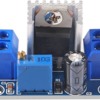Assuming identical motors, wiring them in series will drop the stall current to approximately a quarter of that for parallel-wired motors. But that comes at the cost of reducing the locomotive's maximum speed and pulling power, due to the voltage across each motor being halved. That restriction may not matter for a switcher, but it will for an E8. The lower the drive gear ratio of the locomotive, the greater the likelihood that reasonable speed can be obtained, though pulling power may not be great.
Here are some measured numbers from my Weaver Sharknose model, using a lab bench DC power supply:
Stall current, each motor, 12VDC: 5.0A & 5.2A, Wired in parallel, 10.2A.
Stall current,, each motor, 6VDC: 2.6A & 2.5A. Wired in parallel, 5.1A.
Stall current, motors wired in series, 12VDC: 2.5A.
The maximum voltage that may be applied to the series-wired motors is determined by (a) track power open-circuit AC voltage, (b) effective series impedance of track power source transformer, (c) full-wave bridge rectifier forward voltage drop, (d) rectifier filter 120 Hz ripple voltage under load, and (e) motor drive transistor voltage drop in the Blunami board. I'm only about halfway through my lab-bench investigation of the subject, but it's looking like getting more than 9V across each motor, under load, is a daunting task, when wired in series. For a typical O gauge twin-motored diesel, it may not be possible to achieve stall current within the Blunami specification while obtaining reasonable speed and pulling power. Then it's a matter of deciding what the risks are and whether they're worth taking.






